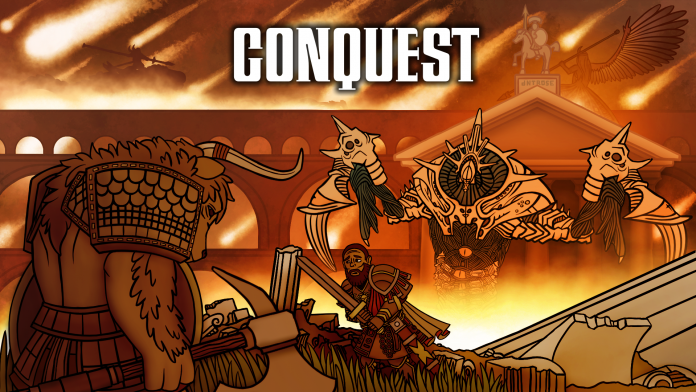Special thanks to Para Bellum for providing a significant amount of review material. If you want to get 10% off and support Goonhammer, make your Conquest purchase by clicking here for US/Canada or here for EU/rest of world and enter code “goonhammer” at checkout.
Welcome to Dinoctober, where through the power of a complete disregard for the Gregorian calendar, Goonhammer is pleased to offer you so, so many weeks of wonderful W’adrhŭn goodness! Who needs other factions when you can have the grandest faction concept in all of wargaming history: orcs on dinosaurs. Who play like elves. For some reason. Today, it’s time for the main event: the W’adrhŭn faction focus! How do you play this army? What rocks, and what reminds us of those icky Spires? Let’s find out!
Conquest Faction Focus: the W’adrhŭn
The W’adrhŭn are not a race of mass-produced, bloodthirsty fighters with overgrown muscles. They are beings designed to wage war; to fight, overcome obstacles, survive and perform under extreme circumstances, with the mindset, senses, physique and endurance to match. They are also not mindless savages that by some accident of fate managed to survive the Fall. They were designed to think, calculate, form strategies and adapt to those of their opponents with cunning, guile, creative solutions and true intelligence. The humans that so readily dismiss the W’adrhŭn as savages have only to look to their own past to see just how great the potential of this young race’s destiny is… and how well equipped it is to meet it.
You have been told of the W’adrhŭn, the fierce orcs riding dinosaurs that conquer all before them. You have been told of the W’adrhŭn, tough, fierce, resilient, the perfect bruiser force for Conquest. But what if everything you were told was a lie?
What if W’adrhŭn… actually played like elves?
What do they play like?
Looking at your average W’adrhŭn, eight foot tall and full of muscle, you’d be forgiven for expecting them to play like how orcs do in every other tabletop wargame – tough, violent, aggressive, crude, resilient. Your average Age of Sigmar, Warhammer 40,000, or Lord of the Rings orc may have a few tricks, but “subtle” isn’t really an adjective you expect to see associated with the green-skinned bruiser of legend. W’adrhŭn don’t play like that at all.
You’ve now picked up an army that’s very fast, fragile, expensive, and heavily reliant on army list synergy and weird abilities that no other faction has. This army, my friends, is the pinnacle of the phenomenon known as elf bullshit, a trait shared by pointy eared gits in all game systems throughout creation. If you’re looking for an army that’s straightforward, this one isn’t for you. But if you’re looking for ways to take a fairly average unit and watch your opponent’s face fall as it pulls off tricks that can break the very core rules of the game? Read on.
W’adrhŭn rely heavily on a mechanism called the War Chant, where you build tokens over the course of unit activations and spend them (usually when it hits three chant markers, although you can trigger a chant early for a lesser effect), and making sure the right effect happens to the right unit at the right time is absolutely crucial to succeeding with this army. You can play W’adrhŭn as a blunt instrument, but you’ll never reach close to the heights of what this army can do without working to build the War Chant in to your game plan, and you’re also just losing out on so much of the flavour this army has to offer.
W’adrhŭn are hard to learn, and hard to master. You’re going to lose a lot before it starts to click, but when it does, watch out.

Strengths
- Hilariously mobile – you have fairly reliable access to triple march or march-charge-clash, a rarity in the Last Argument of Kings, while movement bonuses and special rules are readily accessible.
- Unmatched whombo-combo-ability – if everything goes right, you can pull out some insane tricks, leaving your opponent shaking their head.
- Some best in class units – Thunder Riders are arguably the best impact cavalry in the game, especially when buffed with the War Chant, and at time of writing a Tontorr is the single strongest model in the game.
- Rules which match the narrative – this is present throughout Conquest, but we just wanted to call out our favourite rule here: scary carnivorous dinosaurs are Terrifying, while herbivores are cute and cuddly and don’t have that rule, and instead implacably roam the battlefield with Trample. Balance!
- Orcs riding dinosaurs – okay, this one is just leaning into the cool factor.
Weaknesses
- Fragile – Defence 3 is a rarity, even among frontline bruisers.
- Costly – W’adrhŭn are pointed with the assumption that you’ll be using Chants to power them up, which makes each unit look a bit pricey at first glance.
- Heavily reliant on things going well – because of the first two points, you’ve got very little redundancy if something goes wrong.
- Everything has to work together – you really, really need to build W’adrhŭn as an army, with not only each unit having a role, but each Cult you assign to them having a purpose too. Those Thunder Riders we mentioned above are great, but if you leave them unsupported you’re going to suffer more than other armies trying the same trick.
- Weirdly complex – for a game system built on elegant rules, the War Chant rules are a mess, and it’s going to be a strain to explain them to your opponent (particularly newer players) or understand yourself for a fair number of games.
- Annoying models – Aesthetics and ease of play will push you to three models to a base, but official events will punish you.
- Hard to learn, hard to master – this is without a doubt the most complex army in Conquest. You will struggle before you achieve success.
Army ability – the War Chant
The War Chant mechanic is the heart of what makes W’adrhŭn function. At list creation, you pick from one of three Cults for each Warband to chant from; Famine, Death or War (not all War Chants are chants of War). There’s a fourth cult, Conquest, which is a mandatory choice for some units; it works the same, but with less flexibility as to who can take it. During your turn, any unit which started the Round on the table will generate a token of their chosen Cult and add it to the Sequence when they activate. This is to a maximum of three tokens; if you get to add a fourth (usually through a Character) you replace an existing one.
If you are activating a Regiment (not a Character Stand), you may Chant the Battlecry! Remove all tokens from the Sequence and pick a Cult. The Regiment gains bonuses equal to the number of tokens from that were removed. Two tokens gives you Tier 1, three gives Tier 1 and 2 cumulatively. That’s the simplest version of the War Chant mechanic and the majority of the time what you will be using to power up your army.
The fourth Cult, appropriately called Conquest, adds some dynamism to this system. Conquest tokens are wildcards; you can exchange this token for any of the other three, giving you some tactical flexibility when setting up your Sequence. You may also Chant the Battlecry using the Conquest Cult, by exchanging two or more different cults from the Sequence, in the same manner as chanting the other three Cults. Warbands can’t select Conquest as their chosen Cult at list creation, so you’ll need to take specific units or upgrades to get these tokens into your list.
Finally, there’s a top secret Tier 3 only accessible to units with the Fanatic special rule. They may only chant from their chosen Cult, but they always count as having an extra token of their type. They also gain access to the Tier 3 bonus when they use three tokens, which include extremely powerful effects such as granting Blessed or gaining an extra Action.
There’s a couple of little nuances which are worth mentioning too on War Chants:
– War Chants are the first thing resolved each Activation, ahead of Draw Events, Aura of Death and similar effects.
– If you activate a Regiment and have three tokens in the Sequence, you must Chant the Battlecry. No holding onto them for later (unless you have a Drum Beast; we’ll get to him).
– Characters can’t chant the battlecry. They add to your sequence, but never burn the stack, which makes them very useful for building up a supply of tokens.
– Whilst a Regiment does not add a token to the Sequence when they arrive as Reinforcements, they may still Chant the Battlecry when they arrive. Yes, this does mean your Fanatic Conquest Tontorr can enter the game 21” up the board.
– While the effects of a Chant only last to the end of the Round, the Sequence carries over between Rounds. This lets you ‘set up’ for the next round so you can Chant the Battlecry; this is a great gameplay element, as it means your later units aren’t wasting their tokens, but rather saving them up for their friends (or themselves) next turn, and you get to add another element of inter-turn gameplay to your repertoire.
Yes, this is complex. Yes, the rules probably need a solid rewrite. You’ll learn. You really, really need to learn.
Moving to the beat – putting it in to practice
The War Chant mechanic is without a doubt, the most complex Faction rule in Conquest. It’s like playing Guitar Hero alongside a wargame, as every W’adrhŭn player learns the hard way when you miscount your Sequence and end up giving the wrong units buffs. If you’re starting, we recommend you pick a single Cult to get used to the timings before mixing in different kinds of Cults. Each of the Cults offers a compelling reason to sing that particular song, and the game is balanced such that there are few cases where one is just best.
Famine – Famine is the aggression Cult. Tier 1 nets you 2” additional charge distance and Shock, and Tier 2 gives you Relentless Blows for extra hits on 1s. This is the cult for glass cannon units that want to deliver maximum effect on the charge. Famine Fanatics gain Impact +2 and Glorious Charge with 4 stands or more, turning units like Thunder Riders into something truly horrifying. Well, more horrifying than they already were.
Death – Death is a balanced Cult, and the one you should probably go for if you don’t have a specific plan to build your other units around. Tier 1 gets you the ever useful +1 Clash, and Tier 2’s Flawless Strikes means your 1s to hit completely ignore your opponents Defence. W’adrhun can struggle with cracking high Defence armies, and the fact you don’t need to charge to use it really helps. Death Fanatics gain Deadly Blades and Untouchable, double wounds suffered on a Defence roll of 6 whilst also letting you reroll your Defence rolls of 6 for a little extra protection. Death really shines on high volumes of attacks like Blooded to maximise the Flawless Strikes.
War – War is the defensive Cult, with Tier 1 Rallying the unit and giving +1 Defense. Tier 2 also adds +1 Resolve, but also grants the unit Cleave (1) for some additional armor cracking. While it’s not common to stack defensive options in W’adrhŭn, some units can get to respectable staying power whilst also enhancing their offence. This is a great choice for Veterans; stick them in front of something horrifying, use their free Chant to get them to Defence 4 (!), then, when they only Break instead of die, rally them for free the next turn anyway. War Fanatics gain Blessed and Counter-attack, leaning heavily into the defensive nature of the Cult whilst punishing attackers further.
Conquest – Conquest is a utility Cult, designed to give you universal options that almost any unit will benefit from while also slightly pissing off your opponent. Tier 1 gives the fantastic +3” to your first March (but not Charge!), and Tier 2 increases your Evasion by 2, granting some impressive survivability into high Cleave enemies. Fanatic Conquest however has arguably the best buff of all War Chants, and probably honestly the whole game, granting the unit a free third action. Combined with the previous bonuses, you get regiments that are more mobile than most cavalry that can seize tempo with unpredictable speed and flexibility. And yes, this does mean that your Tontorr with Fanatic Chieftain and Flurry can March 9”, charge D6+6”, then Impact, then Clash, then Trample. Ouch.
This is a complex mechanic, and probably doesn’t have to be this Byzantine in its execution. We’ve also had a lot of experiences where our opponents just shrug and go “sure” while you gain three massive, game breaking bonuses for doing nothing. It can very much be a negative player experience to pull, say, Conquest Tier 3 out of your back pocket, so make sure you’re nice to your friend when you inflict it on them.
That sounds intimidating. Any advice on how to learn?
There’s one silver lining to tackling the learning curve as a W’adrhŭn player, and that’s that as complex as learning how to execute the chant and battlecry can be, it’s actually ok to focus on that while you’re learning. Getting into Conquest in general means learning a lot of things, and every new player takes some time getting their head around how to order their Command Stack. What should you put first? What needs to be delayed? How do you account for the ever-present risk that your opponent will win the supremacy roll and have the first activation?
As a W’adrhŭn player, our advice is that you should put these priorities aside while you’re learning and focus on the beat. You have your own mini-game to play that’s more important than the secondary mini-game of what goes first and what goes last. Instead, start by deciding in general terms what powerful and important you want to activate early-ish and late-ish¸ and then order your stack around making sure those important units hit their battlecries.
An extremely useful tool if you want to make sure you’re chanting with three tokens is to use your characters to pad out your stack. A character always adds a token to the sequence (replacing an existing one if you’re already full) but never consumes the sequence to battlecry, meaning you can use them as a spare beat to guarantee a unit that needs the tokens to battlecry will have them available, even if a unit gets killed unexpectedly early in the turn.
For example, say you want to guarantee that your Fanatic Tontorr chants with a full sequence. Put a unit and a character (probably the Chieftain in the unit) ahead of it, in that order. This means that even if one of the two units is killed, the Chieftain can still chant you up a token so when the Tontorr activates it can add the third, count as having discarded an additional marker, consumes the sequence and executes the desired jump to warp-speed.
Character units
General note – All characters benefit from the Chants of the Regiment that they are embedded in, as long as the Chant is already active that turn. It even lasts for their own actions for Duels, so you can turn any character into an offensive or defensive powerhouse in their own right.
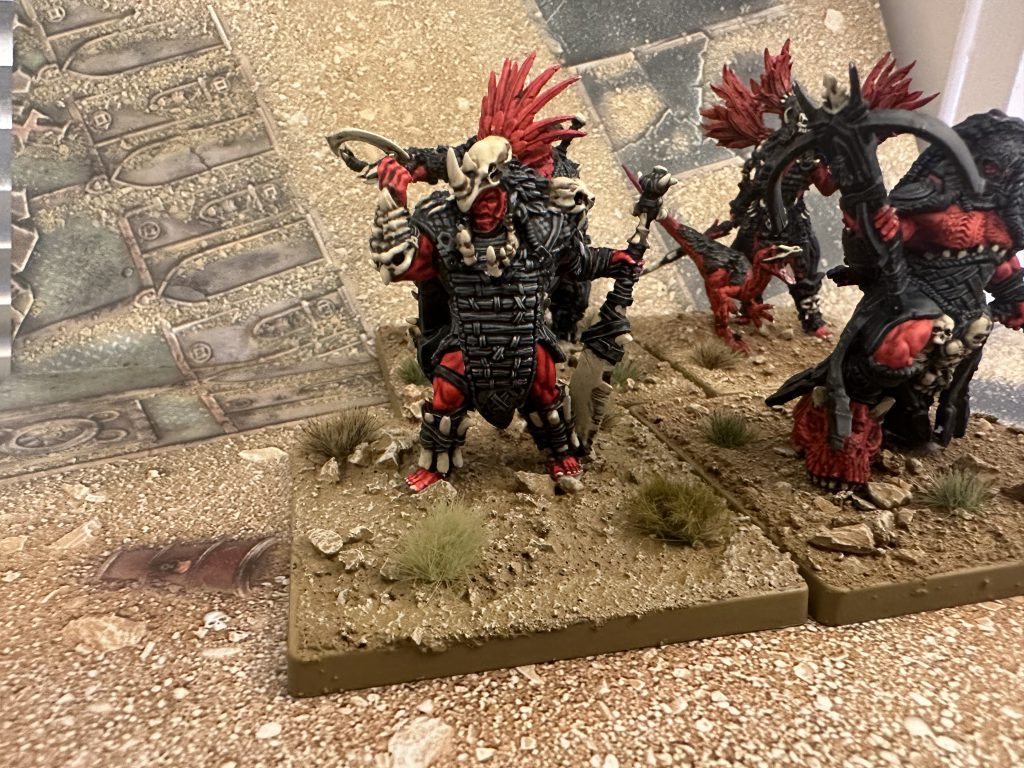
Chieftain
The Chieftain is a straightforward character intended to live in an aggressive unit to support its melee output. Like all W’adrhŭn foot characters, his Attacks and Wounds of 5 makes him an above average fighter, and his Clash 3 and Cleave 2 give him some very respectable unaugmented output. Way of War is a free upgrade for his Regiment, granting Flurry or Double Time. Almost every time you’ll be taking Flurry as W’adrhŭn can improve their maneuverability with Chants anyway, and it synergises nicely with Relentless/Flawless Blows in Famine and Death Cults. W’adrhŭn units tend to have high attack volume, and getting rerolls on those can significantly upgrade that output; three Blooded stands has 19 attacks at Clash 2, so giving them Flurry boosts that from roughly six hits to ten. Bumping them to Clash 3 gets them from ten hits to fourteen, while Clash 4 gets you a whopping 17 probable hits. You’ll notice you gain less from Flurry with each point of Clash you’re feeding into the unit, but 17 hits is still 17 hits – plus the Chieftain’s own!
Supremacy ability Shock Assault – An Always Active ability, friendly units gain Shock while the Chieftain is on the battlefield. As a mobile army with lots of Impact, you’ll get a lot of value out of this Supremacy and it’s rightfully a popular one
Sample Loadout: Death’s Gaze, Violence of Action, Teachings of Conquest 1.
An expensive but powerful option to lead a big unit of eight Braves. Death’s Gaze gives your Regiment Impact 2 at Clash 4 combined with Shock and Death Tier 1, and giving all those supporting attacks from the unit Flurry lets you fish for 1s to trigger Flawless Strike. A 40 Wound tarpit that hits much harder than it should for the cheapest unit in the Faction!
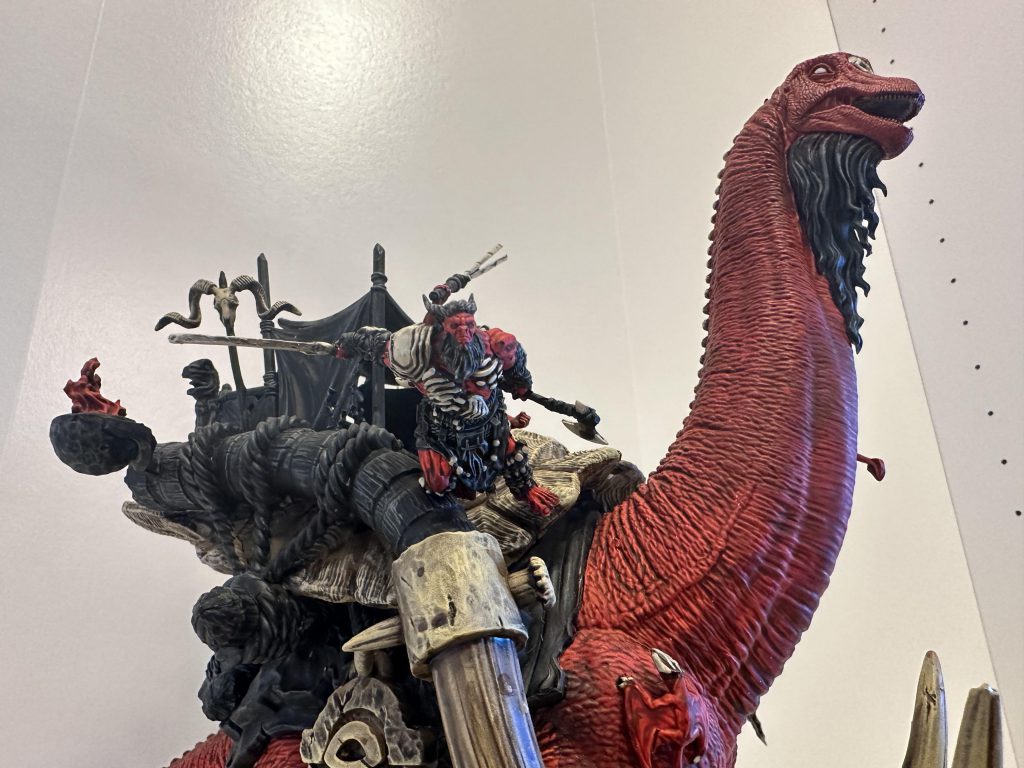
Tontorr Chieftain
The same unit entry as the Chieftain, but this time you take the Tontor Rider mastery and he gets to ride one of his warband’s Tontorrs, making significant changes to how you use the model. The Chieftain adds some higher Cleave attacks to the Tontor which is nice, and also allows you to reroll 6s on the Tontorr’s (but not his) Defence, which over 26 wounds will seriously add up. He now hands out his Way of War ability to a unit within 8” as a Draw Event, changing that rule pretty significantly; instead of the unit he accompanies getting Flurry or Double Time innately, it now takes place at the end of the Resolve Draw Events step for the Chieftain, meaning that your Tontorr does not have Flurry until after the Chieftain manually triggers it. This is a bit of a trap since it’s worded a bit arcanely, and you don’t want to accidentally be cheating by rerolling everything from the Tontorr (and you really, really want to).
Other than granting Flurry to one of the highest volume attack models in the game, the other reason to put a Chieftain on Tontorr is to take the Mantle of the Devoted Talisman. This artifact grants the Regiment Fanatic, letting the Tontor get three Actions when it Chants the Conquest Battlecry. Your lumbering dinosaur can now March 9” (from the first Tier of Conquest), Charge 6+d6” and still Clash. It’s insane how maneuverable this model becomes, and it’s flat out the single most powerful piece in the game right now; concentrating power in a small frontage is always super powerful in Conquest, and it’s always a joy to see someone’s face fall when you point out a potential threat range of twenty one inches to just yeet yourself onto an objective.
You are not mechanically limited to the number of Tontorr Chieftains you can take in your army, but we here at Goonhammer really, really think you should be. Two side by side is 52 incredibly resilient wounds; don’t be a dick about it. As much as we love Fanatic Conquest Tontorrs, maybe, um. Maybe fix that, PB. At least if you can still take more than one giant beastie.
Sample loadout: Mantle of the Devoted, Violence of Action, Tontorr Rider.
This is it: the spice that makes the single best unit in the game. Tontorr Rider is fairly obvious, and you take Violence of Action rather than Rapid Displacement because Oh my God a Tontorr with Flurry. Rapid Displacement gives you Double Time, letting you March three times if you March twice, but Mantle of the Devoted gives you Fanatic, giving you access to the ungodly powerful third tier of Conquest. If you take a Tontorr Chieftain, you take this loadout, and you apologise to your opponent after the game.
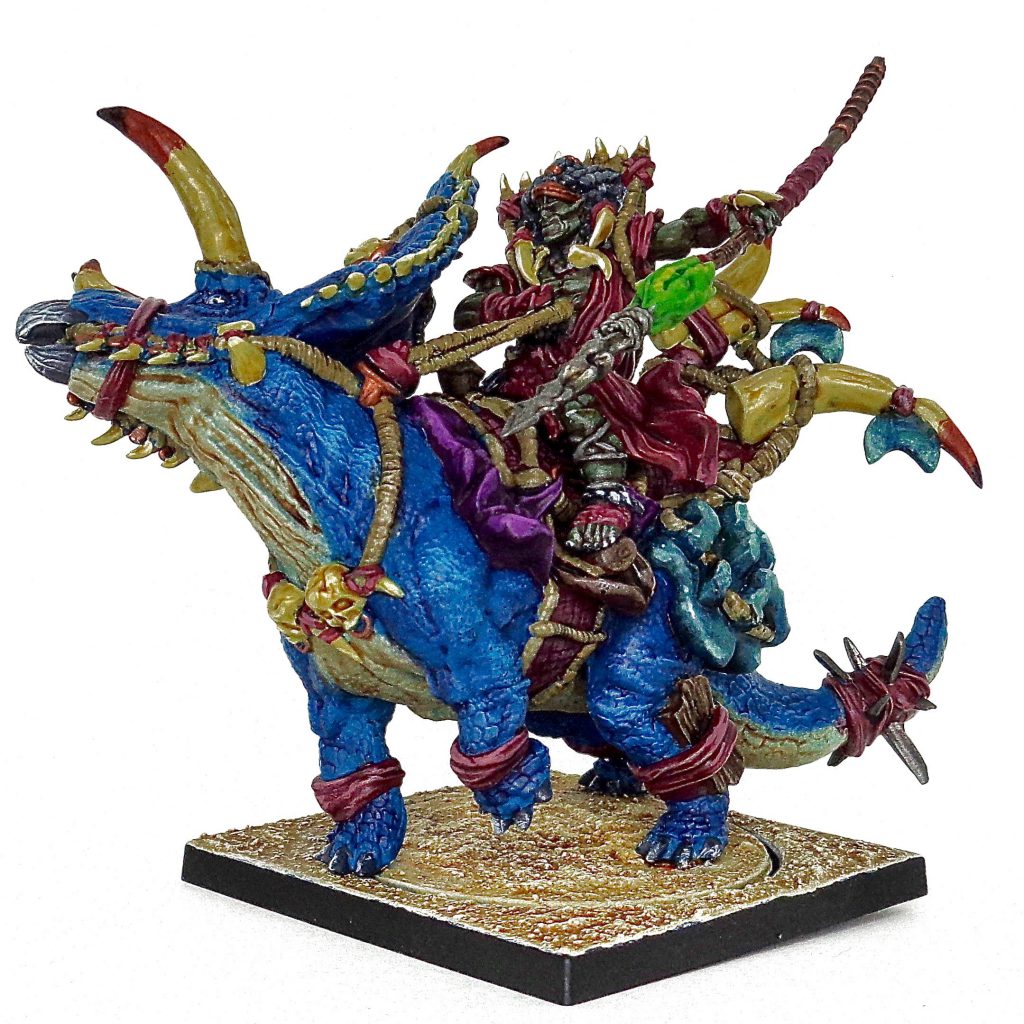
Thunder Chieftain
The Thunder Chieftain is a separate Character whose specialty is Thunder Riders, being the only hero who can take them as Mainstay. He loses any retinue options, but gains an extra Wound, Linebreaker, Impact 4, Brutal Impact 2 andTrample 2. Basically all the rules a Thunder Rider has because, you know, he’s on a triceratops.
With the coolest ability name in the game, Ride the Lightning, he grants Thunder Riders in his Warband Flank, letting them arrive whenever he wants. W’adrhŭn can be a bit of Heavy-loaded army with all those dinos, so getting a free guaranteed heavy unit whenever you want is a pretty big bonus.
100 Kingdoms, step aside. There’s a new Heavy Cavalry king in town.
Sample Loadout: Elder Brontoskalps, Violence of Action
A simple setup, the Elder Brontoskalps is unique to the Thunder Chieftain and gives one of his Thunder Rider units Hardened 1. Combined with War chants, you can get Defence 4, Hardened 1, Blessed Thunder Riders, an extremely powerful and durable unit. Violence of Action gives you the ever-powerful Flurry for your pet Thunder Riders; never leave home without it.
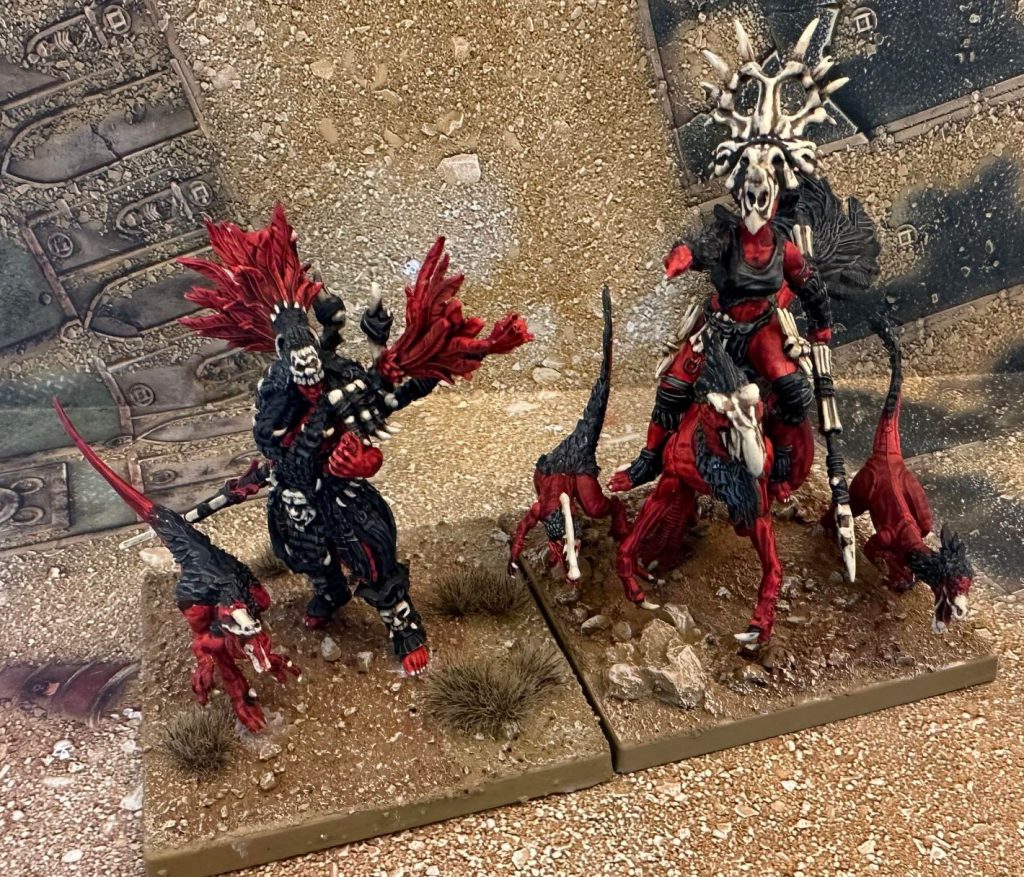
Matriarch Queen
W’adrhŭn have a matriarchal society, where women are the leaders of society and revered by all, tying back to their living Goddess, Ukunfazanes. Whilst rare, some of the women chose to lead their people into battle as Matriarch Queens, representing the most senior commanders in the army and faction as a whole. Matriarch Queens are utility characters with a wide variety of Warband choices, builds and abilities. You’re pretty likely see a Queen in a W’adrhŭn list, both for the units they bring and their utility.
Her Draw Event heals a Regiment within 8” 4 Wounds, which can be incredibly annoying over the course of the game, bringing back swathes of infantry or, if you’re next to a Tontorr, just making your opponent cry as their hard work is undone. At Resolve 4 with the Inspiring Presence rule to ignore Terrifying and Dread, she significantly helps the otherwise fragile units remain in play longer.
Supremacy ability: the Matriarch Walks – As a Draw Event, grant Fanatic to an infantry unit within 8”, and be able to do two Draw Events per turn. The flexibility on this is fantastic, letting you access Tier 3 chants (or accelerate a chant using the extra token effect of Fanatic), though the range and infantry restriction does mean it requires a bit of set up.
Sample Loadout: Brood of Omgorah.
W’adrhŭn often keep their character without upgrades, but in this case the Brood of Omgorah is worth a mention. This upgrade turns the Queen into a Cavalry model, letting her join Raptor Riders and granting her +2 March, Impact 4 and Brutal Impact 2. Whilst the extra maneuverability helps the Queen’s Draw Events, and the Raptors appreciate the extra hitting power and Resolve, this combination makes the Queen a scenario nightmare.
She retains her Heavy class but deploys with the Raptors, letting them score Objective Zones while the Impact hits lets Raptors do multiple wounds to Objectives in a single activation; remember, she’s a Heavy. Combined with Fluid Formation and the ability to shrug off early game shooting with her Draw Event you have an incredible unit to take control of the game from the first turn, getting a scenario lead and putting pressure on your opponent. Expensive, but highly recommended. Just be absolutely sure to not overextend; an absolutely minimum size combo with no upgrades (and you’ll always want upgrades) is over 300 points and only 10 Evasion 2 wounds before the whole thing vanishes. That’s… not a lot of resilience at that price point, and if you push them too hard you’re just getting them closer to your opponent’s ranged forces.
Apex Queen
As with the Chieftain, the Queen can take Apex Mastery and saddle up on an Apex Predator in her Warband, granting the same rerolls of 6s for Defence, but also buffing the Resolve of the Apex too to her own value of 4. If not already used elsewhere, she’ll often take the Mantle of the Devoted to access the extra Action of the Conquest Cult for the Apex. If not, the Kiss of the Dilosaur forces enemies to reroll successful saves from her attacks, which can support the Apex’s already highly capable damage output.
Sample loadout: Beast Drums, Apex Mastery.
Apex Mastery is obviously mandatory, and Beast Drums is just a neat little addon if you have the points; six attacks at Cleave 1 with Flurry is nothing to sniff at if you run into a soft target, and the Apex Predator she’s riding will be doing all the hard work into something tougher! Apex Predators can have issues with hordes, so ensuring you’re putting as many attacks down range as possible is always useful.

Predator
The default hero available through both the One Player Starter Set and Two Player Starter set,
the Predator is a ranged hero who almost all W’adrhŭn players will have. As you can expect from someone called ‘The Predator’, he’s designed to be on the hunt with his abilities focused on targeting the bigger foes on the battlefield. With abilities like Armor Piercing, Deadly Shot and Fiend Hunter many beasts will want to avoid him. Taking Marksmanship for an extra 2 shots will feel almost mandatory to take advantage of these hard hitting abilities.
Like the Chieftain, he has a choice of abilities to grant to his Regiment. Sureshot ignores the effects of Obscuring, almost all the time you will take Fire and Advance to take an additional march action after using your second Action to Volley. This lets your Hunters and Slingers apply their damage, then retreat to safety every turn.
Supremacy ability – Thrill of the Kill – Friendly units may re-roll charges this turn, with Light units gaining +3” to Charge Distance, Medium units gaining +1”, and Heavy units gaining Impact (+1). The most niche of the Supremacy Abilities, and you’re unlikely to ever use or see it. If you do, however, even the threat of it can force your opponent to play more defensively, granting a surprising speed; Veterans could use their free Chant to get +3” movement from Conquest, then another +1” to their charge, granting them a potential threat range of 15”. Not bad for a Medium foot unit!
Sample Loadout: Sacred Censer, Ceaseless Hunt, Marksmanship.
Attached to a unit of Hunters or Slingers with Flint Knapper and you’ve got a nice little extra ranged punch (a whopping Barrage 5 Armour Piercing 1 with Deadly Shot), and more importantly give them Fire and Advance. This lets you sit in a nice defensive position (hopefully that’s just outside of your opponent’s Aim and Fire range) by letting you dart in, shoot hard, then dart back out in classic hit and run style. As a neat little bonus, the Sacred Censer lets you inflict interference on your opponent for a mere 5 points. Neat!
Apex Predator… Predator
Whilst you can mount a Predator on an Apex with the same Mastery as the Queen, he doesn’t really do anything to support it. Lacking any ranged attacks, the Apex doesn’t get anything from his free abilities and he doesn’t have any unique artefacts. Stick with the Apex Queen and let the Predator run with the Slingers instead. The model does have the longest spear in the world though, probably the only monster-mounted model in any game who can reach the ground, which is quite funny.
Sample loadout: Apex Mastery, Death’s Reach or Hide of the Silent Hunter.
A couple of neat little pieces of tech here, Death’s Reach gives you an otherwise lacking point of Cleave, as well as an extra attack. You’re on a dino here, so you’re going to be losing out on some of your ranged power, including the best of Ways of the Hunt, (because your dino wants to get into combat), so you might as well make the most while you’re here. As a bonus, your Apex Predator also gains an attack, in case she wasn’t killy enough. Alternatively, Hide of the Silent Hunter grants you Bastion (1), helping mitigate the Apex Predator’s innate “oh God everything is trying to kill me” weakness by bumping yourself to Defence 4 rerolling 6ss. Either way though, you’re mostly just mitigating existing weaknesses of the model, rather than boosting it to new heights.
Mounted Predator
Not yet released, but that shouldn’t worry you because there isn’t a great use case for him. He’s faster and one wound more resilient, but you lose Retinue and Warband options, and the only reason you’d ever take him is to run him alongside Raptor Riders which don’t really benefit from his abilities. Sure, you can technically shoot with Raptor Riders and use the Predator’s Ways of the Hunt to boost that, but you’re wasting a lot of points if that’s your gameplan. Thrill of the Kill can turn Raptor Riders into missiles with an 11” move then re-rolling charges, but he doesn’t need to be in that unit to grant that. If you’re looking for a hero to run with them, a Matriarch Queen gives better offensive and defensive upgrades and lets you score with Raptor Riders, making her a universally better choice, though there’s probably a (weak) argument to be made for taking the Predator on foot and giving thim the Brood of Omgorah instead. We’re sure this model will be amazing, but the rules right now just don’t support him. Sorry.
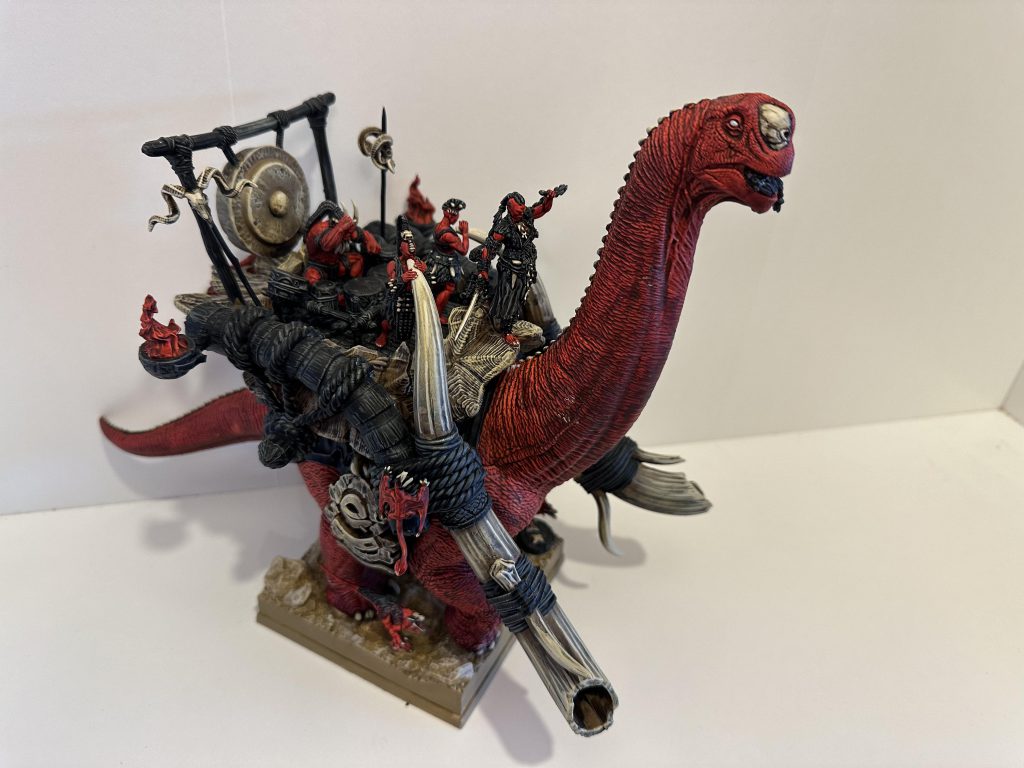
Scion of Conquest
The Scion of Conquest behaves very differently to the other Characters, and is designed to synergise heavily with the Chant mechanic. He’s the only Priest in the faction and his spells either add tokens to the Sequence, utilize the tokens to dispel enemy magic, or turn off enemy Draw Events. You’ll most likely use Crescendo every turn, adding a free Conquest token to the Sequence and activating the next card in your Command Stack if it’s a Regiment. This allows you to ‘accelerate’ getting out three tokens into your Sequence, speeding up how quickly you can get your best Chants off. A useful tactic is to play him last in your Command Stack and cast Crescendo, near guaranteeing you’ll start your next turn with two Conquest tokens in the Sequence and chanting with any of your units on your first activation. Dissonance is potentially powerful, allowing you to discard two Chant markers to dispel a spell cast within 12” or targeting a friendly unit within 12”, but the range makes that challenging and Chant markers are so valuable it’s hard to see a spell that could be worth sacrificing two of them. Cacophony on the other hand just shuts off enemy Draw Events within 12”, which can be devastating to armies like Spires.
Don’t let the Priest thing fool you though, this guy is still a beast in combat. Boasting the same 5 Cleave 2 attacks as a Chieftain and the Resolve 4 as the Queen, he brings some of the best parts of both Characters and can fight with the best of them.
Supremacy ability – Vision of Conquest – Every token you add to the Sequence this Round is a Conquest token, and you may activate your units in any order you choose rather than creating a Command Stack at the start of the Round. The maximum flexibility choice, you get one turn to pick any Chants and any order to activate in, letting you perfectly respond to your opponents moves. Particularly effective in high activation count armies where you can time your activations and chants exactly how you want them. On the other hand, your order of activations is still constrained by the need to accumulate chant markers to battlecry, making this supremacy less flexible than it might seem at first glance. This Supremacy sometimes gets a bad reputation for being for beginners to the faction, but the ability to react to your opponent’s actions ‘live’ can be huge, especially in high activation lists.
Sample Loadout: Beast Drums, Arcane 1.
The Scion should always upgrade with Sacred Censer or Arcane 1 to get an extra dice on his spells. Attunement 4 is easy to hit but given how critical it is to add tokens to the Sequence the extra reliability goes a long way for very cheap. Beast Drums gives an extra attack and Flurry, making him more offensively powerful than a naked Chieftain. Stick him in a unit of Chosen of Conquest and he’ll seriously increase the output of the units damage, whilst also going up to Evade 3 with their Chant to let you confidently Duel almost any enemy characters.
Scion on Drum Beast
Like all Characters, the Scion can ride his Drum Beast into battle with the relevant Mastery. He brings the extra offense that the Chieftain does, buffs the Resolve of the dinosaur to 4 (stacking nicely with Oblivious) and lets you reroll 6s for Defence. He also gains the Draw Event Drum Beat, adding an extra Token to the Sequence matching any existing type. Given he himself adds a Conquest Token, this may as well read “add a free Conquest token”, but it gives you the ability to cast Crescendo to go from 0-3 tokens and activate a Regiment in a single go, which is very powerful.
There are some slight issues in that you would want the Mantle of the Devoted normally on a monster rider like this, but without a Retinue and having already taken a Mastery it’s hard to get his spellcasting past the more risky Priest 4 to guarantee Crescendo. If you’re running the Mantle elsewhere though it’s a solid pick still.
Sample Loadout: Drum Beast Mastery, Sacred Censer
Without the ability to increase his priest dice with masteries or a Retinue if he’s on a music beastie the Sacred Censer is an almost mandatory pick. Other than that, he’s another example of a W’adrhŭn hero being run light and lean. Well, as light as a multi-tonne Drum Beast can be.
Light Regiments
Hunting Pack
Hunting Pack are an unusual unit in W’adrhŭn. They don’t use Warchants, Irregular means they don’t push up your Reinforcement line and with just 3 Wounds at Defence 1 they are incredibly fragile. So why take them?
Their upside is that they are extremely quick (Vanguard with Movement 8 to move up 24” in Turn 1) and with 6 Attacks each they can really put the hurt on light units. Ideally you get them into the flank for Opportunist to kick in and give them rerolls to hit too, which gives them some pretty serious offensive power. Take one or two in minimum units and rush them up a flank to hide behind some terrain (or rely on Loose Formation, which halves the amount of hits from ranged units). Your opponent now has to accept a dangerous flank or rear charge, or spend precious activations removing a relatively inexpensive unit from their backfield. Sadly, these guys can’t benefit from your Chants; the little dinosaurs can’t sing!
Robert Bass: It’s worth mentioning that Hunting Packs are also a mainstay choice for the Predator. Though the hero cannot join with the little buggers, if you chose to have him riding the Apex then you could have a fun ‘dino only / murder chicken’ thematic warband.
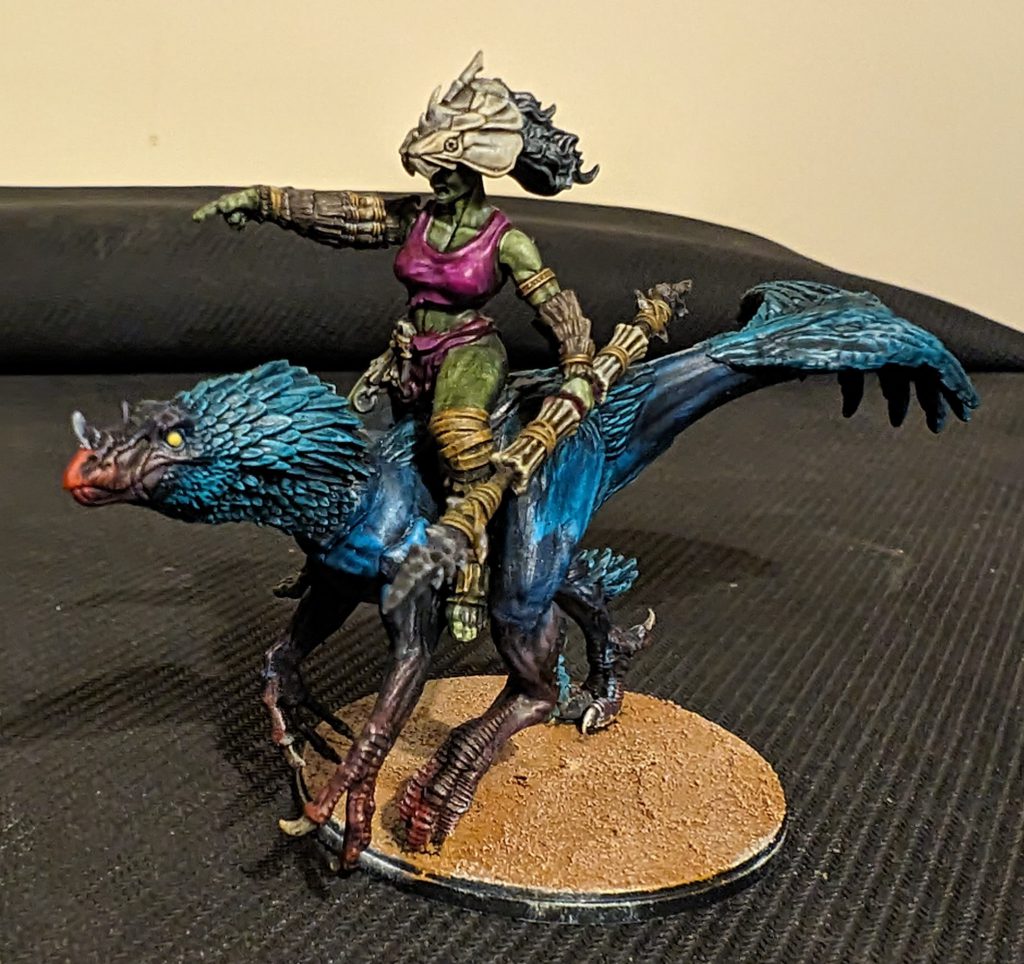
Raptor Riders
Now we’re talking. Raptor Riders are one of the best Light units in the game and rightfully feared. Move 8 and Fluid Formation gives them some incredible speed, and with 5 Attacks each with innate Flurry to reroll failed hits, they can put some serious damage onto all but the highest Defence Units. They’re effective with any of the Cults with Flurry stacking nicely with Flawless Strike/Relentless Blows, Conquest giving them even more Movement and some spicy Evade 3 or War giving their high volume of attacks with Cleave!
At 5 Wounds Each with native Evade 2, they’re reasonably durable from ranged attacks but don’t expect them to stand up in protracted combat. Also, their ranged attack is a trap; Barrage 2 and Volley 2 at 12” Range means that they’ll almost certainly get counter charged by whatever they’re shooting at with negligible output. Units of 3-4 are great, and very common in W’adrhŭn lists for some early game presence, particularly if you drop a Matriarch Queen on Brood of Omgorah in there to make her scoring in a Light unit. Be aware though, that these guys will not stand up to a dedicated combat unit, and their price can rapidly stack up; it’s very easy to overextend them to try and apply some early pressure and eat up an enemy Light unit or two, but you’re very, very likely to then immediately lose them as they’re alone and unsupported. Play carefully.
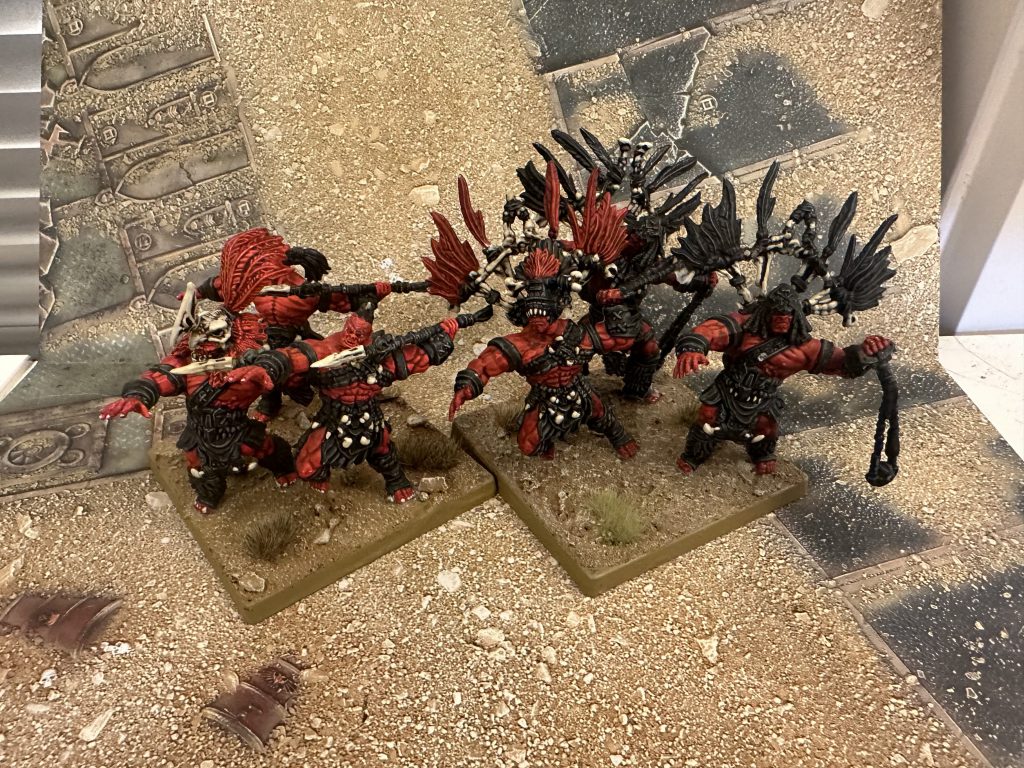
Slingers
Restricted to Predators and Mounted Predators, these guys are your elite ranged unit, throwing out a dizzying amount of brrrrt and breaking a couple of the rules of the game in the process. Base Volley 3, Barrage 4 and range 18” makes these guys a top tier choice to reach out and touch someone, even before adding in their Torrential Fire rule granting you extra hit for every two hits you make if within effective range, and for every two wounds they cause forcing a Resolve check on your enemy, one of very few units who can still make models panic from a shooting attack. Your two officer options are a Skirmisher granting +1” March and a free Withdraw action (not great, because you should never, ever be in combat with these guys; wet tissue paper looks down on their defensive statine), and a Flint Knapper, who should be in every unit you ever build. This 15 point upgrade lets you ignore Hardened (X) (meh) while also rerolling 6s to hit, taking three stands from a probable six hits to probable nine, and four stands (our preferred option) from 9 hits to 13, helping maximise Torrential Fire. That’s a lot of value wrapped up in one dude. These guys can be fun to pair with a Predator with Ceaseless Hunt, letting you move-shoot-move in a single turn. Sure, you’re not getting to aim, but you’re already Volley 3 and now have a 24” effective range. Neat!
General Cross: I’ll make the case for the Skirmisher over the Flint Knapper here. With no Armour Piercing except on the Predator, Hardened isn’t doing much, and the Knapper is only giving the reroll 6s which is still good but not an autopick. The Skirmisher not only adds to their March, but their Fire and Advance moves too keeping them that little bit more mobile. The free Withdraw means that if you get March/Charged to be tied up, you can withdraw for free, Reform then Volley into whatever charged you.
Hunters
Your other ranged unit, Hunters are Mainstay for Predators, Mounted Predators and Matriarch Queens, and are a bit more anti-armour compared to the Slingers “drown them in dice” way of war. Only Volley 2 and 14” range, they’re a bit harder to get a lot of value out of, really needing that Aim action, but plonking them down behind a melee infantry unit and in front of a Brute or Monster can really let them shine, particularly with the mandatory (for Sockbert, at least) Flint Knapper officer. They can get a Skirmisher (don’t), but the Tracker is really worth considering, granting Flank (not that useful as a Light unit will come on pretty fast anyway), but more importantly Fiend Hunter. With Armour Piercing (1) and Deadly Shot a full barrage (heh) from these guys can put a worrying amount of hurt onto something big – four stands is 17 shots rerolling everything, and move-shooting into, say, a unit of Minotaur Thyreans takes off two stands, and getting an Aim in there takes that to three. This is a great unit, you just need to put a bit more work into getting it to work and stay alive – with Defence 1, anything that touches it *will* kill it.
Medium Regiments
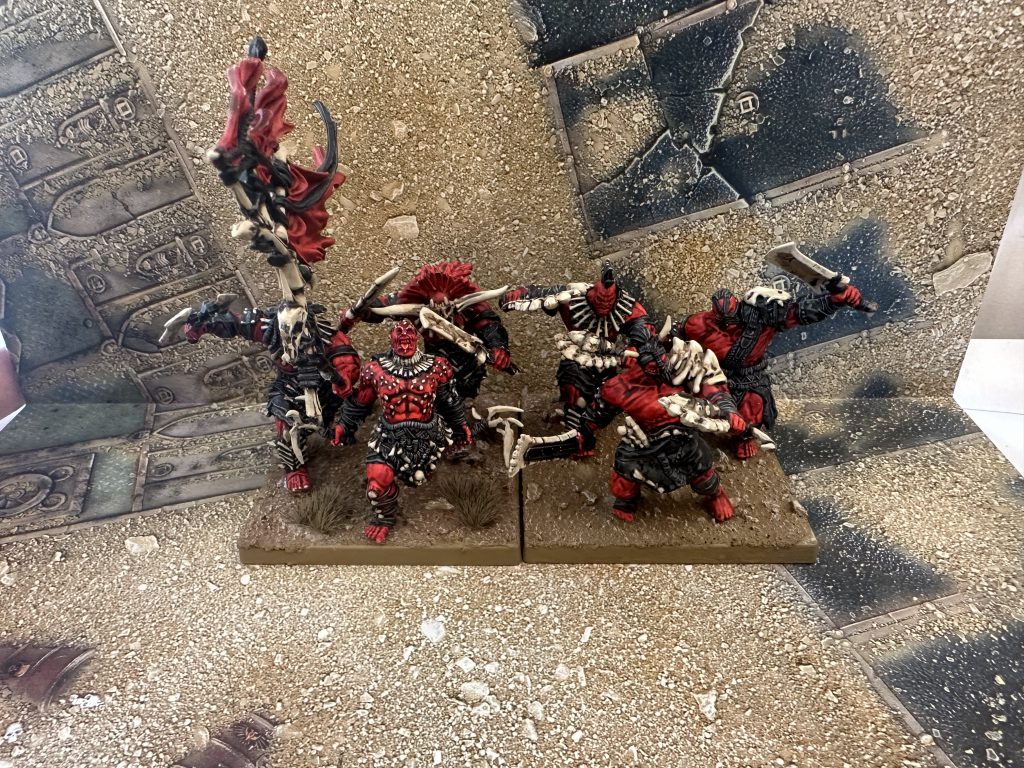
Blooded
A mainstay unit for every released leader, these guys throw a lot of attacks out, and not much else. Five wounds like a standard W’adrhŭn unit with Defence 2 and Evasion 1, they’re not going to stop a lot of damage coming in, but can soak more than you’d expect when it hits them. Their main point of interest is the six attacks per stand they can drop, which is a shocking number of dice when you throw four stands into something (our preferred size – they really need an extra stand to survive in combat, or even to get there). Four Officer choices here; a Champion gives an extra attack each (!), a Skirmisher grants +1 March and a free Withdraw action, Tracker grants Flank and Fiend Hunter, while the Aberration grants the unit Lethal Demise. Of these, we lean heavily towards the Aberration. Lethal Demise is an incredibly powerful rule that forces your opponent to really consider how badly they want those Blooded dead. More than once we’ve seen a unit of Agema or Raiders hold off from making a charge because the Blooded functionally get to attack twice – once when they die, and once on their own turn. It’s a great tool to throw on a back field objective, where you can force an opponent to engage in strength rather than throw down something light to challenge you.
Other than the Aberration, Tracker is also powerful. Of the two abilities, you’re paying primarily for Flank, which is always worthwhile and helps respond to any early pressure your opponent puts on the scenario, or exert pressure of your own. Fiend Hunter is more situational but should be viewed as free bonus – it would be great if you had any cleave at all; even buffed up from chants, we don’t feel very optimistic about their chances into most Brutes or Monsters.
Champion is a bit of a “win more” button without adding much tactically (though a Blooded unit with a Champion and Chieftain giving flurry is a little hilarious), and Skirmisher won’t let you get out of the way of anything that wants to charge you anyway, so give that one a miss. Really, just grab an Aberration; the model looks incredible, and Lethal Demise isn’t just great for removing enemy stands, it can shape the whole battlefield with how it makes your opponent move around them.
Braves
For 20 points less than Blooded, you lose two attacks, a point of Resolve and the lone pip of Evasion. In return, you get Shields, Support (2), and Bloodlust. Your only Officer option is the Champion (granting +1 attack), so you’ll probably take that, meaning you’re only 5 points cheaper with those alternate rules. I’ll be honest, this isn’t a unit that we’ve had great success with; it hits a lot less hard, and a single conditional pip of Defence doesn’t help nearly as much as you think it would keeping them alive, and they won’t do nearly as much damage when they make contact. Bloodlust allows you to charge the turn you come onto the board, which is… let’s just go with “unlikely” given that 5” movement, while potentially forcing your pseudo-defensive unit to make a charge you don’t want them to, perhaps off an objective. Overall, they’re less versatile with less output (even in larger bricks Blooded get more attacks) and just a bit of a miss.
General Cross – Blooded aren’t great in small units, but they are absolutely worth a look in a big unit of 6+ stands as one of the few true anvils W’adrhŭn can bring. They are one of the cheapest Wound per point efficiencies in the game with Support to let them fight in deep formations. Affectionately known locally as the “Big Blob of Braves”, take them with a Chieftain (see the Death’s Gaze build to give them Impact attacks and Glorious Charge too) for Flurry and Cult of War to buff them to Defence 4 and with Cleave 1 and watch them grind down units they have no business winning over.
Chosen of Conquest
The only “Chosen” unit to be released at the time of writing, Chosen of Conquest are an elite unit that both have and bring a lot of utility to the table. Their initial statline seems a little underwhelming for their premium cost (Clash 3, 5 Attacks at Cleave 1, Impact 2, Defence 3 and Evade 1) aside from their extraordinary Wound count of 7. Their potential is truly explored when using the Fanatic rule, letting them use all three tiers of Conquest Cult. Remember, this also means they can’t take any other Cult.
Tier 2 brings their Evade up to an impressive 3, letting them duel with elite units like Varangian Guard, but their real niche is using the extra 3” March and an extra action. This turns them into an extremely flexible and mobile unit that can speed across the board and engage units that don’t want to be. Quantity of attacks will bring them down, and without the other chants they can struggle to get through high Defence units, so use their maneuverability to hold up units you don’t want running through your lines.

Veterans
Veterans are an interesting choice that are only available with Chieftans as a mainstay. With 6 Wounds and Defence 3 with Shields they are a more durable version of Braves for another 50% cost. Their unique ability Forged in Battle allows them to use the Tier 1 bonus of their Cult (or Conquest) as a Draw Event, as long as they didn’t Chant the Battlecry. You can effectively always benefit from a Tier 1 Battlecry every turn whilst still adding tokens to your chosen Cult for future Chants. Their Officers include a Champion for an extra Attack per stand, or the Chief for Flurry. You’re going to get into some maths here: four stands give 21 attacks, which with Flurry is roughly 16 hits at Clash 3 and Flurry. That’s a lot, but if you have a way to get their Clash up (Shock, charging, Inspire, Cult of Death…), that goes to 25 attacks and 17 hits with Clash 4. Clash 5 (charging with Shock, which is pretty easy to get) you’re up to 19. This is largely a use-case question: if you’re expecting them to hold the line, Flurry from a Chief is your best bet. If you’re throwing them forward to get Charge bonuses and Shock, the volume from the Chieftain may be the way to go.
Sockbert: This unit is incredible. I was initially very lukewarm on them at first, but plonking them in a cult of War makes them very resilient (Resolve 3 and functional Defence 4 from the front is nothing to sniff at). There’s something very inspiring about surviving a charge that should have killed you, only to immediately lose Broken with a free War Chant. This unit just doesn’t shift on the defence, and can be exactly where you need them to be if they Chant Conquest. I keep them with a Chief, since they’re largely holding my flanks while dinosaurs push down the centre. This unit isn’t flashy, they’re just really, really good.
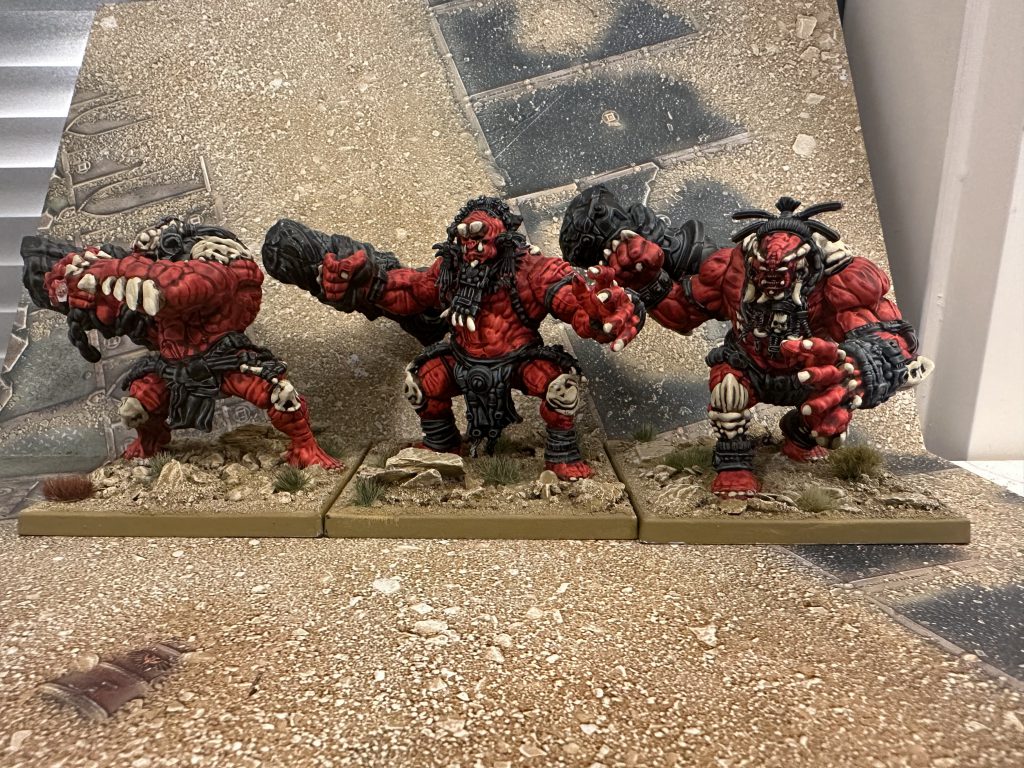
Warbred
Mainstay for a Matriarch Queen and Restricted for a Chieftain on foot, Warbred are your ogre-type beasties in a W’adrhŭn army. With only a 6” March, they’re not fast, but once they make contact they’ll be punching down into most units, with Impact (2), Relentless Blows and Cleave (2) on five attacks per stand. That’s a lot of potential damage, and Burnout can help you get that Clash value to dizzying levels – in an army with a Chieftain Warlord granting Shock, a charge, Burnout and Death you can get these guys to clash six if you wanted to for some reason. You wouldn’t get much value, but it’s neat you can do it! They are a little fragile at Defence 3 especially when using Burnout, so we recommend either treating units as disposable, or taking them in large blocks to ensure that you get a big enough hit in before they go down (just don’t use Burnout unnecessarily if you’re fielding a block of four or five as the Decay will start to really add up).
Heavy Regiments

Apex Predator
The Apex Predator is the W’adrhŭn equivalent of a cruise missile. Sleek, fast and able to cause a Significant Emotional Event in whatever it is you hit. Its Movement 7 lets it outpace many units and with 11 Cleave 2 attacks with Terrifying, it can put serious hurt into elite units. The prime target is Brutes and other Monsters, where Fiend Hunter gives it rerolls to hit and ensuring the hit lands. For a quick bit of math, Clash 4 on the charge (if you’ve got Shock) into a Resolve 3, Defence 3 Brute unit like Minotaur Haspists is 8 wounds is fourteen wounds, even before Impact. If you’re facing another W’adrhŭn player, make sure you get the charge on their Apex Predator first; who charges, wins.
It’s a good time to mention that all W’adrhŭn Monster dinosaurs have Bellowing Roar, allowing them to add Conquest Cult tokens to the sequence and meaning they can only gain the benefits of the Conquest Cult. The +3” of March from Tier 1 helps get the Apex into positon whilst the Evade 2 gives it some reasonable staying power against Armour Piercing or Cleave (though she’s still not the toughest thing on the board). As mentioned in the Matriarch Queen though, taking one with Mantle of the Devoted gives you access to the Tier 3 three actions chant, giving the Apex a 17+d6” threat range with a Clash at the end too, plus the Queen’s own attacks!
Overall, a powerful and effective choice at a fairly mid-range cost for W’adrhŭn too. Great for rushing a flank and going after elite units and monsters, just be careful you don’t bite off more than you can chew – the Apex Predator isn’t a bruiser piece. It wants to pick out and engage specific targets, adding its offensive output to existing fights or using its speed to eliminate isolated enemy units. W’adrhŭn have a different dinosaur for full frontal bruiser scraps, which we’ll get to soon.
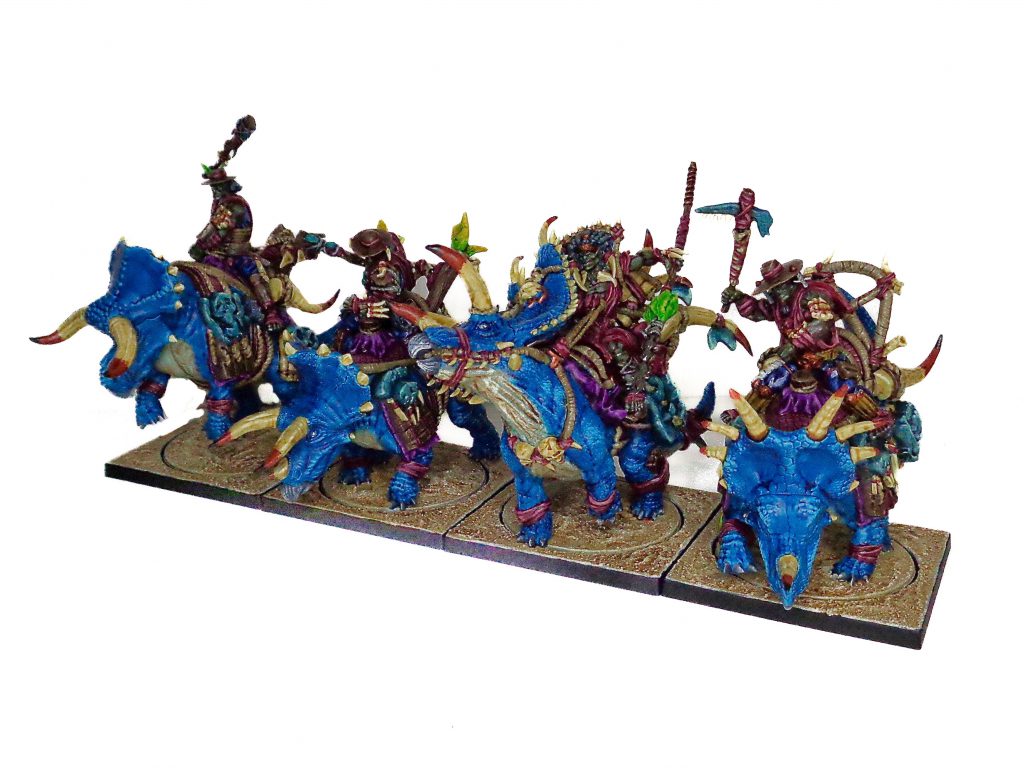
Thunder Riders
We reckon Thunder riders are the best heavy cavalry unit in the game (come at me, Order of the Ashen Dawn). Once in combat they’re fine (five attacks with Linebreaker), but when they make the charge they have Impact (4), Brutal Impact (2) and Linebreaker, with Unstoppable helping you get there in the first place. Four of these (you may want to consider sticking a Thunder Chieftain in there as the fourth stand to give them Flurry and Flank, and unlock them as Mainstay) is a horrific 16 hits on the charge ignoring a tonne of Defence and a further 8 auto hits at the end thanks to our beloved Trample.
Their drawbacks are that they’re expensive (80 points per stand), surprisingly fragile (Defence 3 and 6 wounds is nice, but an infantry stand has 5) and, most importantly of all, slow, with a March of only 6”. This makes it very easy for your opponent to put something inconvenient in front of them or (even worse) get the charge into you first. Unstoppable helps, but only to a degree.
On paper, these guys are a poster child for Famine as a cult, as even that Tier 1 gives them a rerollable 8+d6” charge and Shock, which really helps with those impact hits. If you’ve already got Shock from a Chieftan Warlord though, War becomes the best cult for them, because it boosts boost the defences of the Thunder Riders up to significant levels (especially when combined with the Elder Brontoskalp) and adds cleave for sustained brawls. The extra Defence is particularly important if you’re going for an aggressive March + Charge + Trample into the enemy. This will do a lot of damage but expose the Thunder Rider to counter-assault, and boosting their defences with War makes this significantly more difficult for your opponent to respond to.
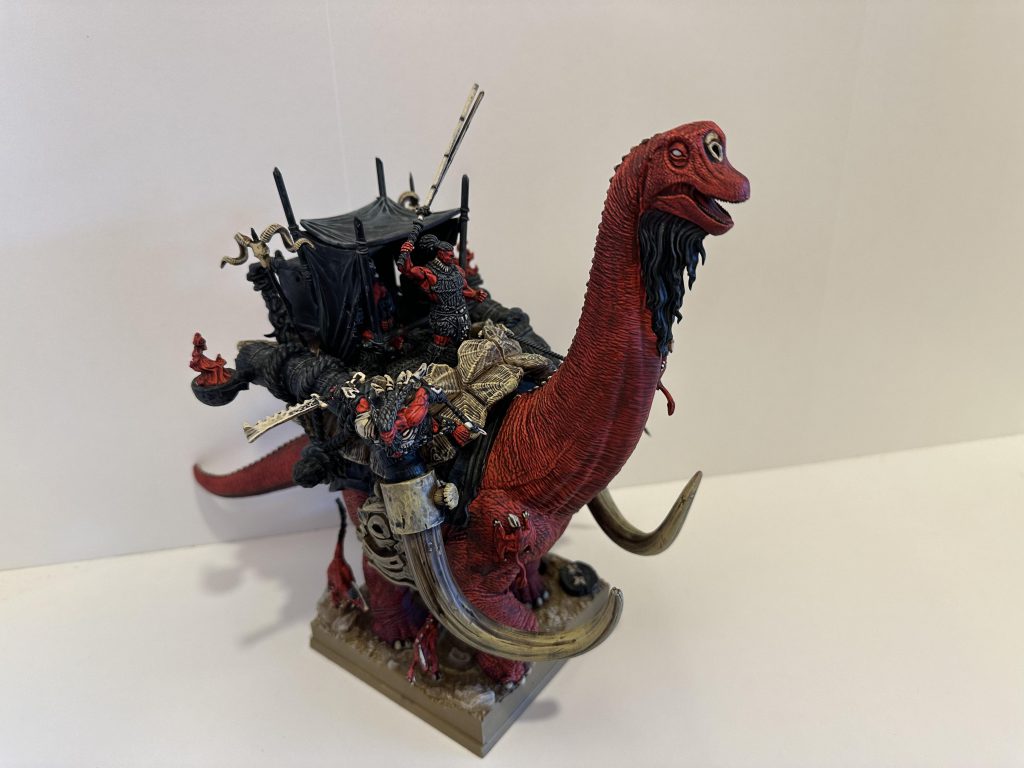
Tontorr
The Tontorr is a behemoth on the battlefield, both in size and in stats. At a whopping 310 points you get a 26 Wound monster with 6 Brutal Impact attacks, 16 Cleave 1 attacks with Linebreaker and Relentless Blows, and Trample 10, just in case your opponent thought they could catch a break after you Clashed. Monsters don’t have damage penalties either, so until you get that last Wound through the Tontor is still hitting at full capacity. Fearless and Oblivious means you can shrug off a fair amount of Resolve damage too, keeping it around for much longer, while the You and What Army? rule for your Chieftain on top means they can mock those petty Duel actions until the time is right to strike.
Where the Apex merely enjoys the Bellowing Roar ability, the Tontor thrives on it. Evade 2 on a massive Wound pool is fantastic for staying power, particularly with a Chieftain letting you reroll 6s on Defence, and the Trample hits means that a March and Charge of 15+d6” still puts a lot of damage on whatever it hits. Taking the Mantle version only extends this further, giving unparalleled speed and maneuverability to a model that frankly shouldn’t be able to move that fast.
It’s worth noting that while the Tontorr is a big damage pool, it’s certainly not indestructible. Grinding down big infantry blobs is fine, but any decent Cleave attacks into it will chew through its wounds, and incidental shots from ranged units adds up too. You can try and keep a Matriarch Queen nearby to heal up the damage and let the dinosaur keep on trucking as long as you can, but this is adding a lot to the cost of an already atrociously expensive single model.
You can take as many of these units as you can fit with points, up to a possible four in a single army. Just… don’t. From a purely “I like to win” perspective, two is as high as we reckon you can go without sacrificing things that win you games, like objective holders and ranged utility pieces. From an “I like to have friends” perspective, two is just not a fun thing to face, and three is even worse. Sure, they may win, but it’s not going to be fun for anyone. Two Tontorr Chieftains side by side is 52 Defence 3 wounds rerolling 6s; one alone requires over 50 hits without Cleave to take it down, two is just a massively negative player experience.
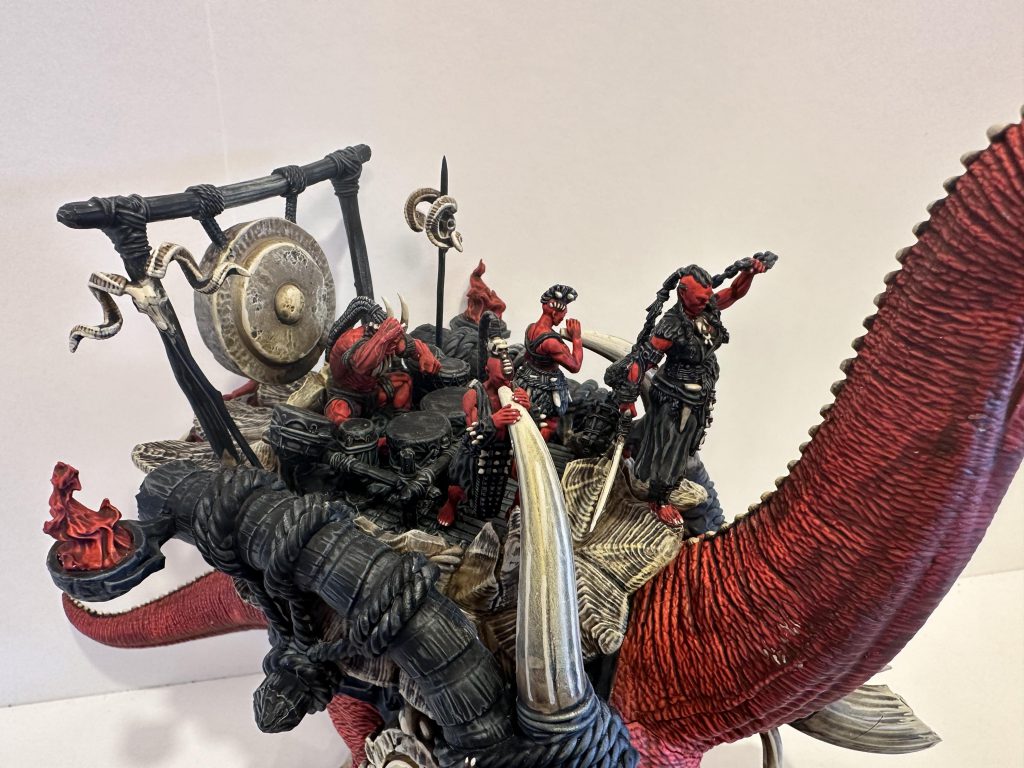
Drum Beast
The utility version of the Tontorr, this model swaps four attacks and Relentless Blows for some unique ways to mess with the Chant mechanic. The primary benefit is that a Drum Beast lets you ignore the need to chant with a Regiment while having three tokens. At first glance this may not look like a massive buff, but it can help you fix mistakes or deal with an unexpected friendly unit dying and throwing out your Sequence plans that turn which, under the right circumstances, can be monstrously powerful; it’s really just up to you as to whether or not this adds enough value when you could instead be beating face with a Tontorr. You’ll almost certainly take a Scion on top to utilise his draw benefit of the extra Conquest token, who supports the Drum Beast and brings his own hitting power too; the two of them together are far more value and impact than just the Beast alone.
At 330 points and in a limited warband, this is a more niche pick than the Tontorr. If you have to pick between them, we’d recommend the Tontorr as the extra hitting power will be generally more impactful than the utility functions of the Drum Beast.
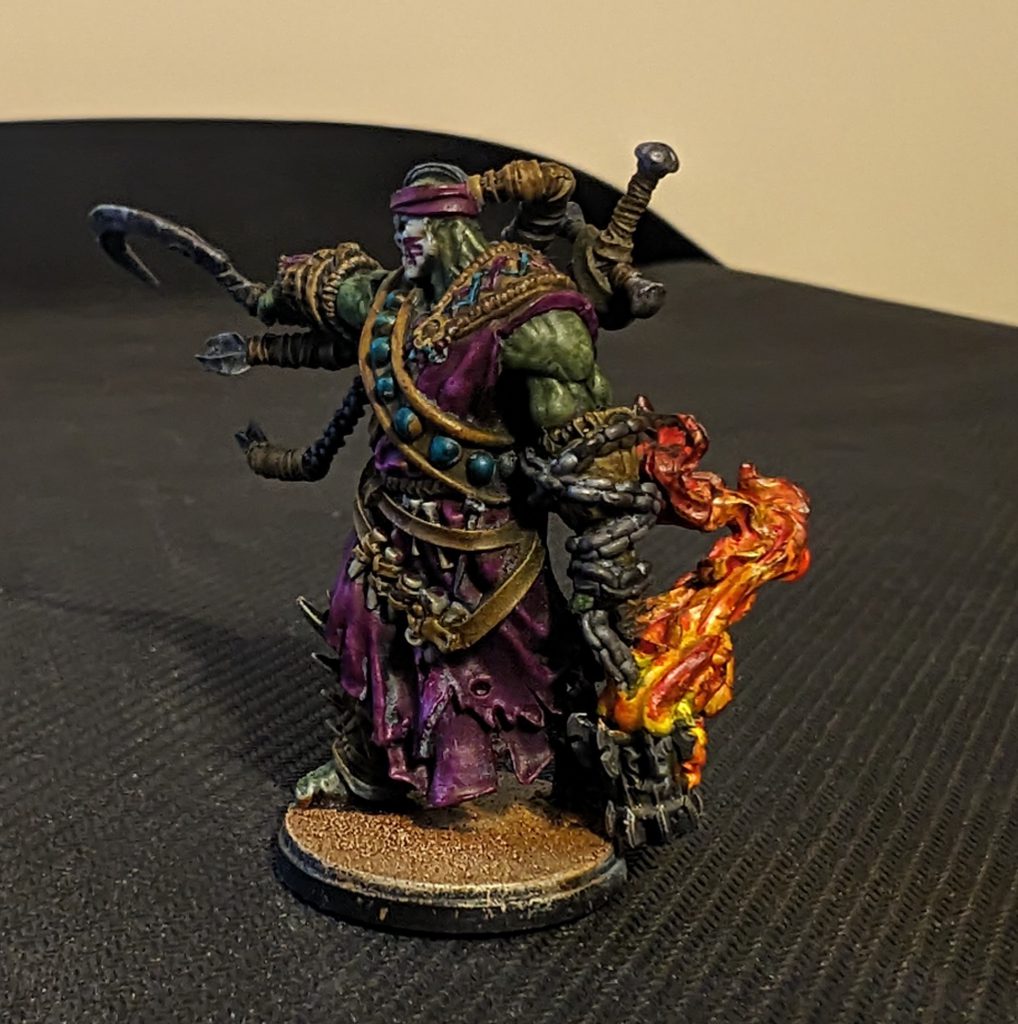
Sample lists
Do you hear the dinos sing? Singing the song of angry orcs
== (Warlord) Chieftain [135]: Death, Mantle of the Devoted, Violence of Action, Tontorr Rider
* Tontorr (1) [310]:
* Veterans (4) [285]: Standard Bearer, Chief
== Chieftain [125]: Death, Kiss of the Dilosaur, Violence of Action, Tontorr Rider
* Tontorr (1) [310]:
* Veterans (4) [285]: Standard Bearer, Chief
== Predator [110]: Death, Sacred Censer, Ceaseless Hunt, Marksmanship
* Hunters (4) [215]: Flint Knapper
* Slingers (4) [225]: Flint Knapper
Magos Sockbert: This is my current go-to tournament list, and is absolutely not something that gets brought out against friends. The two (!) Tontorrs are an ungodly pain to deal with; plonking them both in the middleish means you own that board. The ranged units tend to come in as a brick to almost double-tap whatever threat is against them, and four stands of Veterans form incredibly resilient anchors. This list isn’t particularly subtle, it’s just good. There’s no chaff here; the Chieftain uses Mantle of the Devoted to slam a three action Tontorr with Flurry wherever the hell he likes (which honestly should probably be nerfed a bit) while his buddy just sort of exists as a menace to back him up. Oh, no, you’ve finally killed a single Tontorr, how terrible! Have another.
Thunderstruck
=== The Last Argument of Kings ===
Thunderstruck [2000/2000]
== (Warlord) Thunder Chieftain [185]: War, Elder Brontoskalps, Violence of Action
* Thunder Riders (4) [330]:
* Blooded (4) [175]:
== Matriarch Queen [145]: Death, Brood of Omgorah
* Raptor Riders (4) [250]:
* Hunters (3) [155]:
== Scion of Conquest [120]: War, Primordial Splinter, Tontorr Rider
* Chosen of Conquest (4) [310]:
* Drum Beast (1) [330]:
General Cross: A balanced list of Lights and Heavies, more often than not you’ll have your entire list on the board by Turn 3. Play fast and aggressive, using the Chosen and Raptors for fast scenario pressure and following up with the Thunder Riders after. The Drum Beast anchors the list and can let you quickly generate Conquest tokens to allow the appropriate Cult choice you need for a situation.
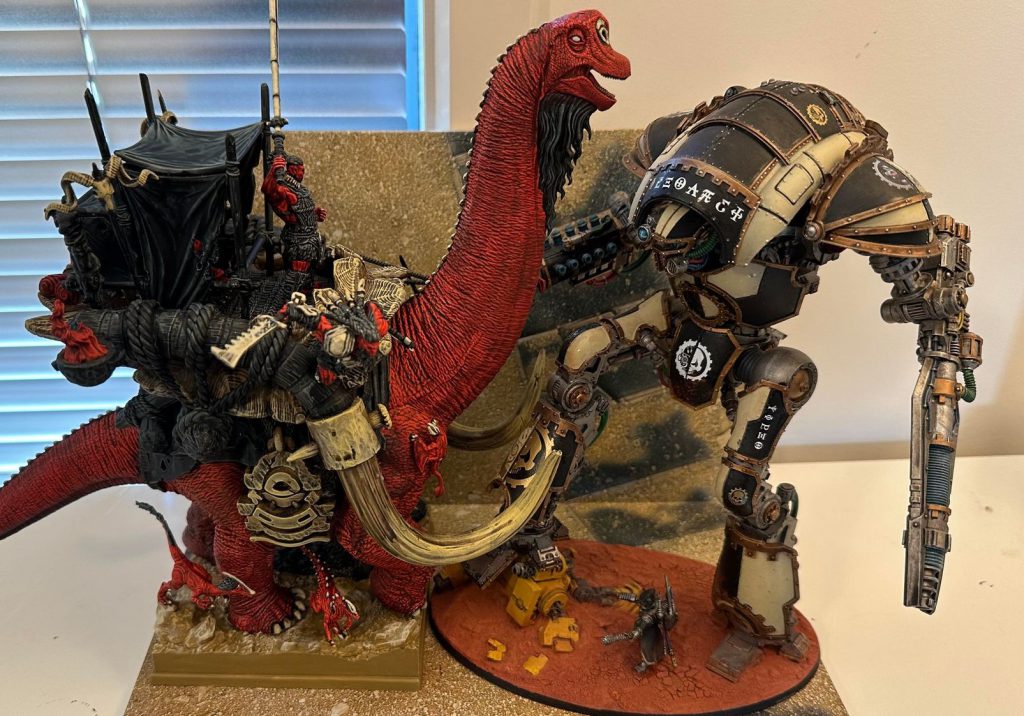
‘Ere we go, ‘ere we go, ‘ere we go…
W’adrhŭn is the epitome of a high skill floor and ceiling army. They aren’t a pick up and play faction, and it can take some serious thought and practice to get them to operate at their full potential. But when you get your perfect sequence of chants aligned with a Just Right Command Stack to watch hundreds of tonnes of dinosaurs and orcs crash though your opponent in perfect synchronization, it can bring a level of satisfaction that can be very hard to live. Give them the time needed to learn them, and you’ll be thankful that you did.
Also, you get to make dinosaur noises.
Enjoy our thoughts? Check out the rest of our Conquest coverage here, and make sure to check back next week for the next article in our Dinoctober series, a whole month of focus on the W’adrhŭn!
Special thanks to Para Bellum for providing review material. If you want to get 10% off and support Goonhammer, make your Conquest purchase by clicking here for US/Canada or here for EU/rest of world and enter code “goonhammer” at checkout.
